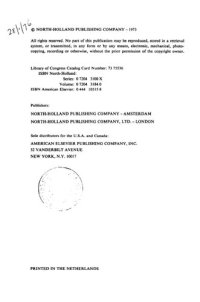
Ebook: Studies in economic planning over space and time.
Author: Takashi Takayama, George G. Judge
- Series: Contributions to economic analysis
- Year: 1973
- Publisher: American Elsevier Pub. Co.
- City: Amsterdam
- Language: English
- djvu
This is a monster of a book: 723 text pages containing thirty-four separate essays by fifty-two authors. It is enough to intimidate any casual reader but presumably the price of seventy-two dollars will insure that there are no casual readers. Moreover, it is in some ways an odd collection of essays, including reprints of some old articles which in their day were not inspiring and one or two which would add lustre to any book. There are many, perhaps too many, examples of useful and interesting, practical applications of spatial and temporal programming models. And there are examples of uninteresting and quite impractical models. Perhaps no one but a reviewer will ever sit and read through this book. Yet it will serve as an excellent reference text and a source of readings for courses in planning techniques.
The book starts slowly, however. The first eleven essays, in two-hundred and twenty-five pages, include some distinguished names but only three useful surveys of various types of planning models in papers by Wilbur R. Maki and James E. Angus, Thomas A. Miller, and Roger F. Riefler, and a competent application of regional input-output analysis to United States freight shipments by Karen R. Polenske. The homage to Tinbergen and Frisch by the inclusion of their papers is understandable.
Most of the next five-hundred pages contain twenty-two examples of applications of programming techniques to a variety of spatial and intertemporal allocation problems. Nearly all of them are competent and interesting in themselves. And, occasionally, they are ingenious. The examples make the point, perhaps too well, that there are many important, potential uses of programming techniques. The examples also demonstrate that it is almost always necessary to adjust the technique to the particular problem and data set. The only puzzle is why it was thought necessary to make these points with such redundancy. The models fall into a few distinct classes. Most are optimizing models which have a familiar linear or quadratic programming structure and whose most immediate progenitors are Takayama and Judge themselves. Most involve problems of the location and/or distribution of agricultural production. Most of the papers are concerned with the United States, but there are also applications to particular Japanese, European and international production and distribution problems.
The book starts slowly, however. The first eleven essays, in two-hundred and twenty-five pages, include some distinguished names but only three useful surveys of various types of planning models in papers by Wilbur R. Maki and James E. Angus, Thomas A. Miller, and Roger F. Riefler, and a competent application of regional input-output analysis to United States freight shipments by Karen R. Polenske. The homage to Tinbergen and Frisch by the inclusion of their papers is understandable.
Most of the next five-hundred pages contain twenty-two examples of applications of programming techniques to a variety of spatial and intertemporal allocation problems. Nearly all of them are competent and interesting in themselves. And, occasionally, they are ingenious. The examples make the point, perhaps too well, that there are many important, potential uses of programming techniques. The examples also demonstrate that it is almost always necessary to adjust the technique to the particular problem and data set. The only puzzle is why it was thought necessary to make these points with such redundancy. The models fall into a few distinct classes. Most are optimizing models which have a familiar linear or quadratic programming structure and whose most immediate progenitors are Takayama and Judge themselves. Most involve problems of the location and/or distribution of agricultural production. Most of the papers are concerned with the United States, but there are also applications to particular Japanese, European and international production and distribution problems.
Download the book Studies in economic planning over space and time. for free or read online
Continue reading on any device:

Last viewed books
Related books
{related-news}
Comments (0)